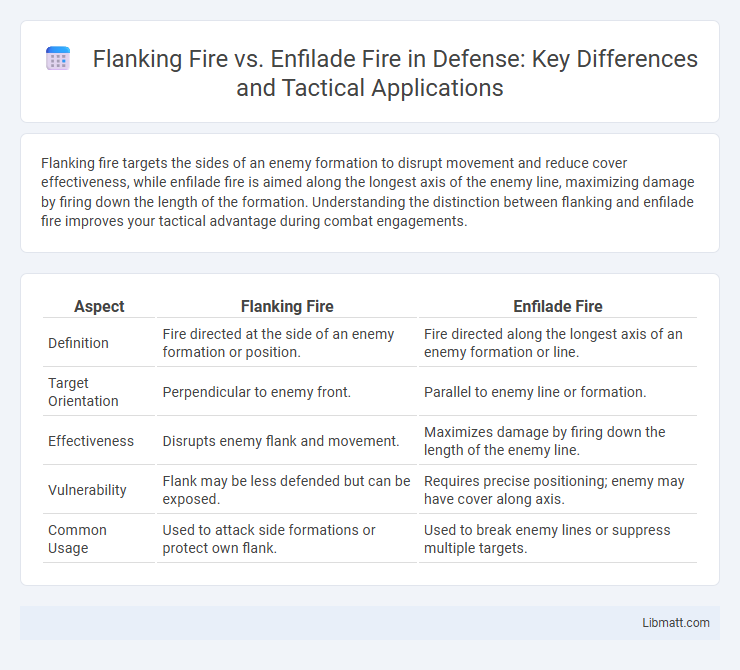Flanking fire targets the sides of an enemy formation to disrupt movement and reduce cover effectiveness, while enfilade fire is aimed along the longest axis of the enemy line, maximizing damage by firing down the length of the formation. Understanding the distinction between flanking and enfilade fire improves your tactical advantage during combat engagements.
Table of Comparison
| Aspect | Flanking Fire | Enfilade Fire |
|---|---|---|
| Definition | Fire directed at the side of an enemy formation or position. | Fire directed along the longest axis of an enemy formation or line. |
| Target Orientation | Perpendicular to enemy front. | Parallel to enemy line or formation. |
| Effectiveness | Disrupts enemy flank and movement. | Maximizes damage by firing down the length of the enemy line. |
| Vulnerability | Flank may be less defended but can be exposed. | Requires precise positioning; enemy may have cover along axis. |
| Common Usage | Used to attack side formations or protect own flank. | Used to break enemy lines or suppress multiple targets. |
Introduction to Flanking Fire and Enfilade Fire
Flanking fire targets the side of an enemy formation, maximizing damage by exploiting weaker lateral defenses, while enfilade fire directs shots along the longest axis of the formation, causing devastating effect through consecutive targets. Both tactics prioritize positioning to enhance combat effectiveness, with flanking fire leveraging lateral vulnerabilities and enfilade fire focusing on longitudinal penetration. Understanding these firing techniques is crucial for military strategy and increasing battlefield lethality.
Definitions: Flanking Fire vs Enfilade Fire
Flanking fire refers to gunfire directed along the side of an enemy formation, targeting its length to inflict maximum casualties and disrupt movement. Enfilade fire occurs when gunfire is aimed parallel to the longest axis of the enemy line, often catching troops in a vulnerable, extended position. Both tactics enhance firepower effectiveness by exploiting the enemy's formation geometry to increase damage.
Historical Origins of Both Tactics
Flanking fire originated in ancient warfare as armies sought to exploit the vulnerable sides of enemy formations, maximizing damage by targeting less protected areas. Enfilade fire emerged prominently in the Napoleonic era, where linear infantry tactics allowed volleys of gunfire to sweep along the length of enemy lines, causing devastating casualties. Both tactics reflect the evolution of battlefield strategies aiming to maximize firepower effectiveness by attacking enemy units from advantageous angles.
Key Differences Between Flanking and Enfilade Fire
Flanking fire targets the side of an enemy formation, exploiting lateral vulnerability to maximize damage and disrupt their line. Enfilade fire, by contrast, sweeps along the length of a formation from a position parallel to its orientation, causing sustained casualties by firing down the line. The primary difference lies in the angle of attack: flanking fire strikes from the side, while enfilade fire sweeps longitudinally along the formation's axis.
Tactical Applications in Modern Warfare
Flanking fire targets the enemy's side, exploiting vulnerabilities in formation to maximize damage and disrupt command structures, essential in urban and close-quarters combat. Enfilade fire directs shots along the longest axis of enemy trenches or formations, increasing lethality by hitting multiple targets lined up in a row, commonly used in defensive operations and ambushes. Both tactics enhance battlefield control by leveraging terrain and positioning, improving the effectiveness of infantry and armored units in combined arms warfare.
Advantages of Flanking Fire
Flanking fire offers significant tactical advantages by targeting the enemy's side, where defenses are usually weaker, increasing the likelihood of inflicting higher casualties. This type of fire creates overlapping fields of attack, disrupting enemy formations and reducing their ability to maneuver effectively. Compared to enfilade fire, flanking fire often achieves greater surprise and exploitation of terrain, enhancing battlefield control and operational effectiveness.
Strengths of Enfilade Fire
Enfilade fire maximizes damage by targeting enemy formations along their longest axis, exposing multiple troops to continuous fire. This technique increases lethality and suppressive effects, reducing enemy maneuverability and morale. Its effectiveness is enhanced in trench or column-based formations where the line of fire intersects the greatest number of soldiers.
Case Studies: Famous Battles Utilizing Each Method
In the Battle of Hastings (1066), Norman forces effectively employed flanking fire by attacking the English shield wall from the sides, disrupting their formation and securing victory. The Battle of Gettysburg (1863) exemplifies enfilade fire as Union troops utilized artillery positioned on Cemetery Ridge to fire along the length of Confederate lines, maximizing damage and defensive advantage. These historical examples demonstrate how strategic application of flanking and enfilade fire shaped battlefield outcomes by exploiting enemy vulnerabilities.
Strategic Countermeasures Against Each Fire Type
Effective strategic countermeasures against flanking fire include deploying overlapping fields of fire and using terrain to limit exposure on the flanks. To counter enfilade fire, units benefit from adopting dispersed formations and utilizing smoke screens or cover to disrupt the enemy's line of fire. Your forces must assess the battlefield layout to implement these tactics efficiently, minimizing vulnerability to both fire types.
Conclusion: Choosing the Optimal Fire Strategy
Selecting the optimal fire strategy depends on battlefield conditions and tactical objectives, with flanking fire targeting the sides of an enemy formation to exploit vulnerability while enfilade fire maximizes damage by firing along the longest axis. Enfilade fire often results in greater casualties and disruption due to its alignment with enemy lines, but flanking fire offers flexibility in maneuver and reduces exposure to return fire. Commanders must evaluate terrain, unit positioning, and enemy formation to determine whether the concentrated power of enfilade fire or the tactical advantage of flanking fire best achieves mission success.
flanking fire vs enfilade fire Infographic

 libmatt.com
libmatt.com